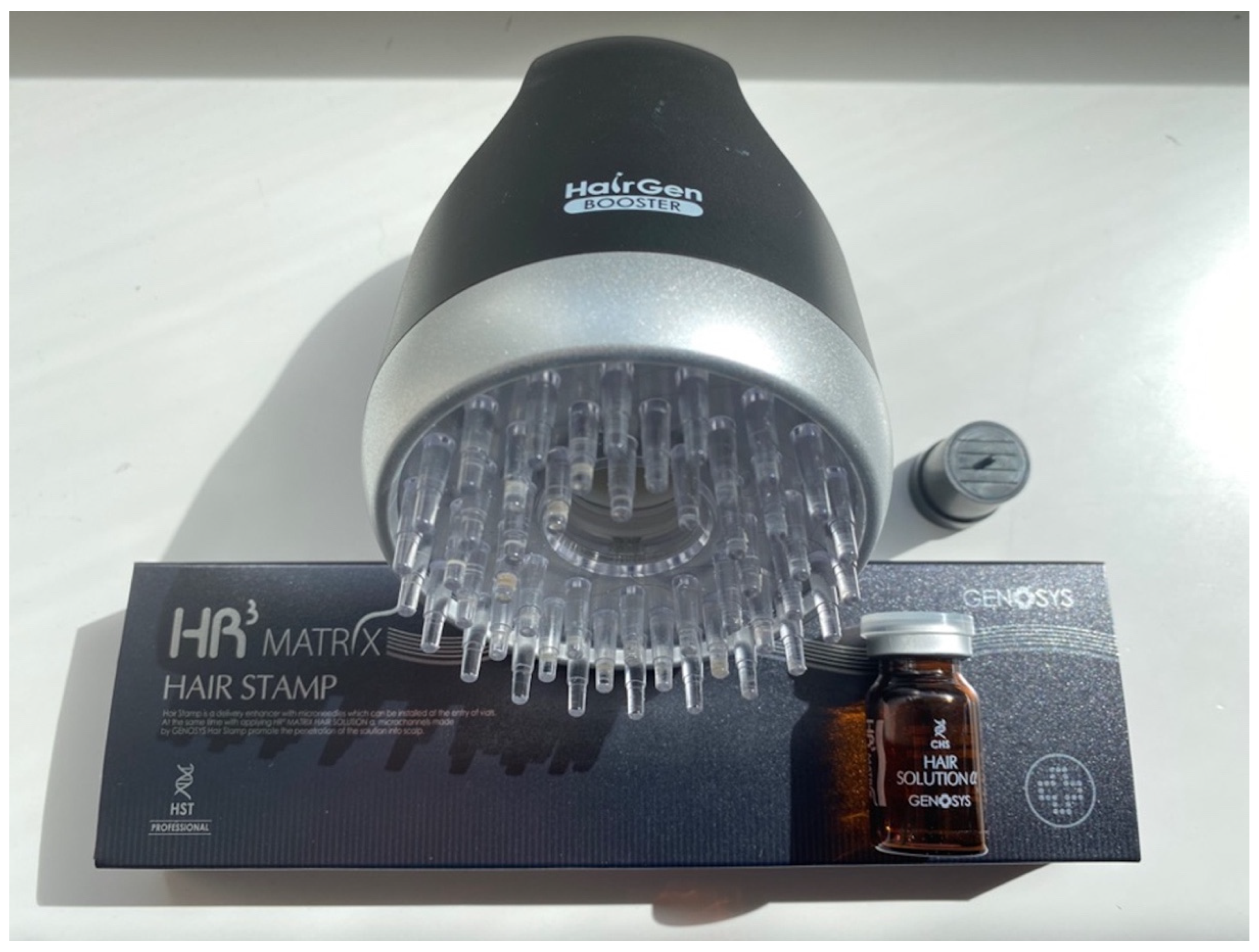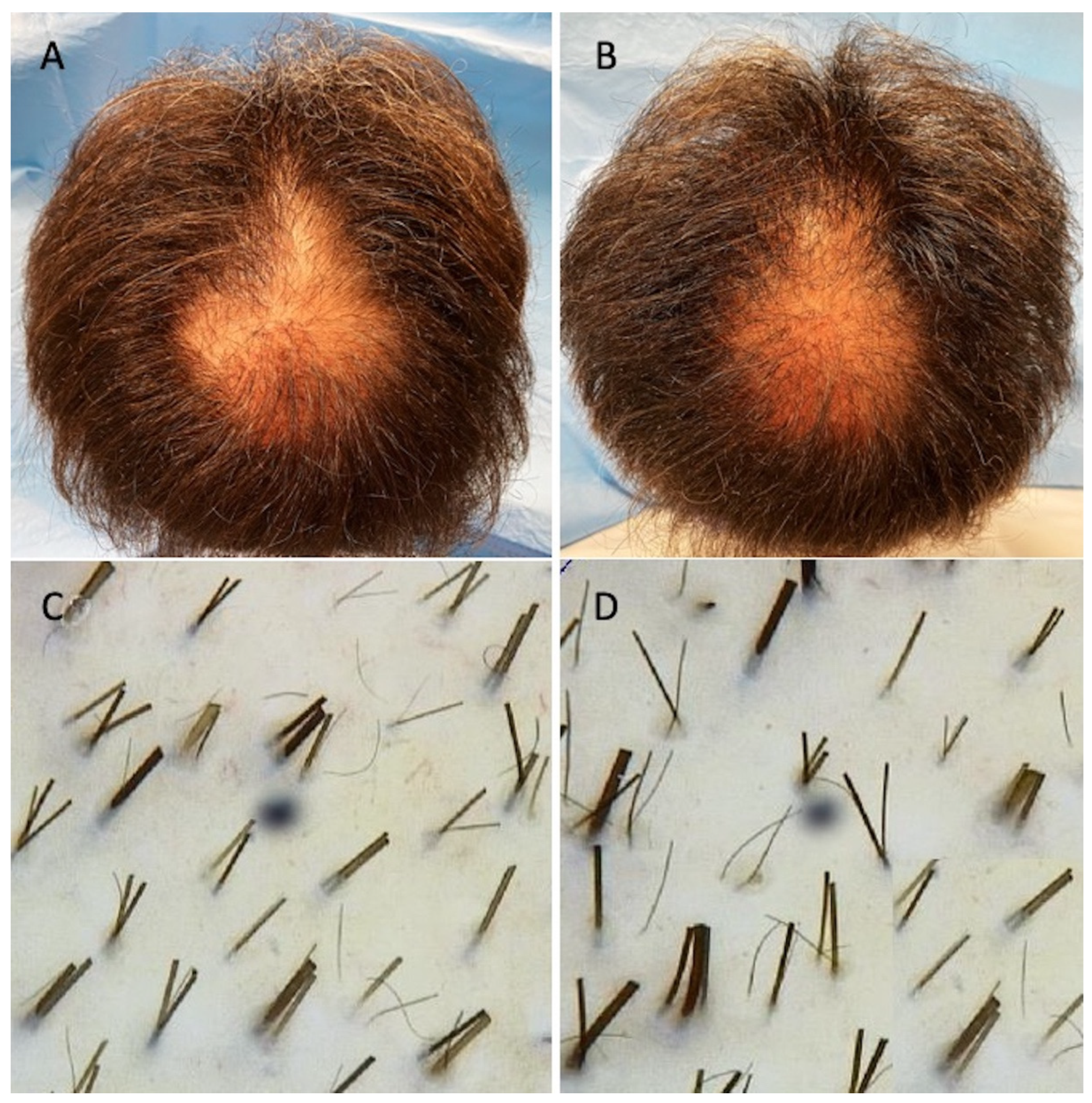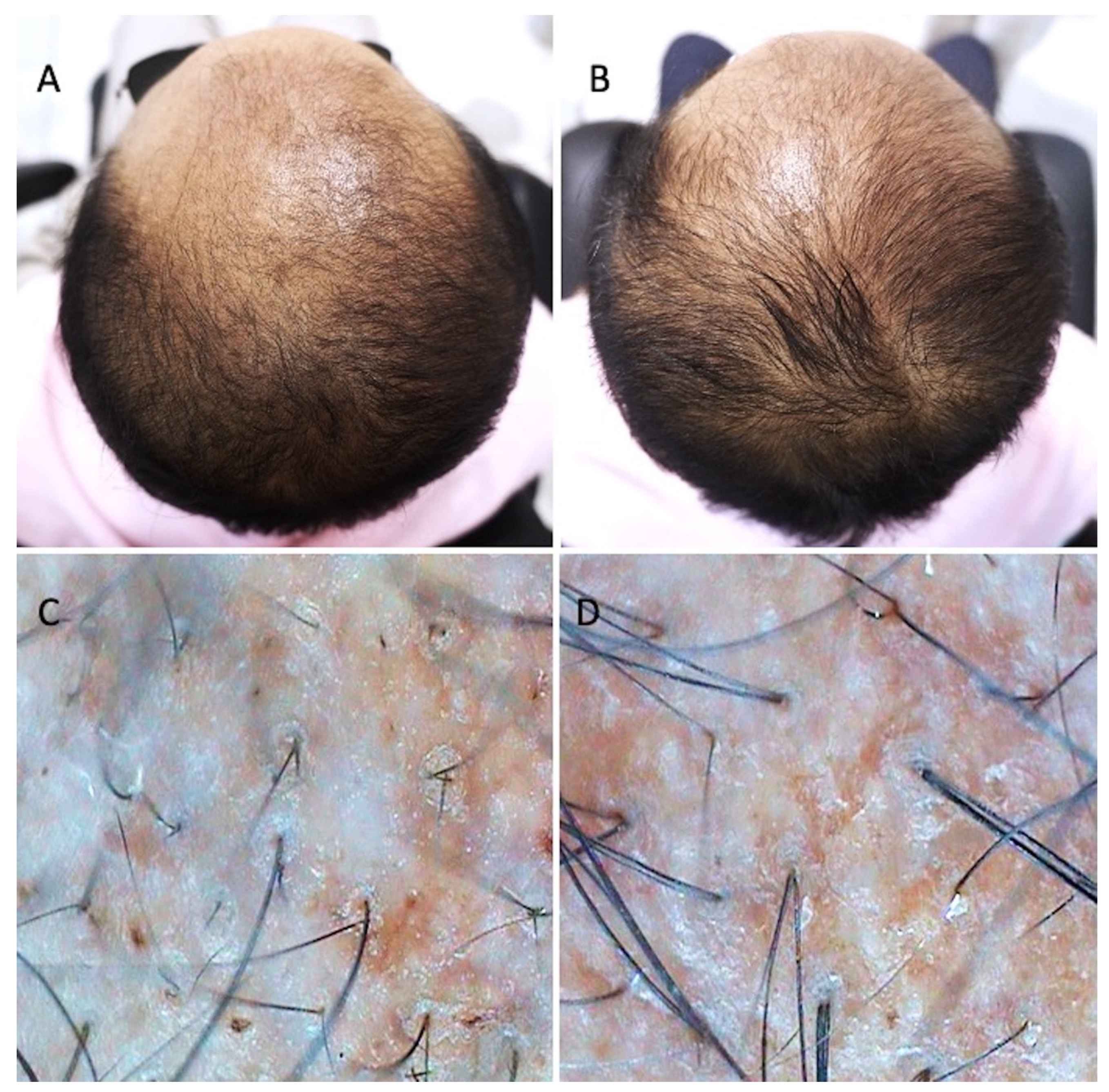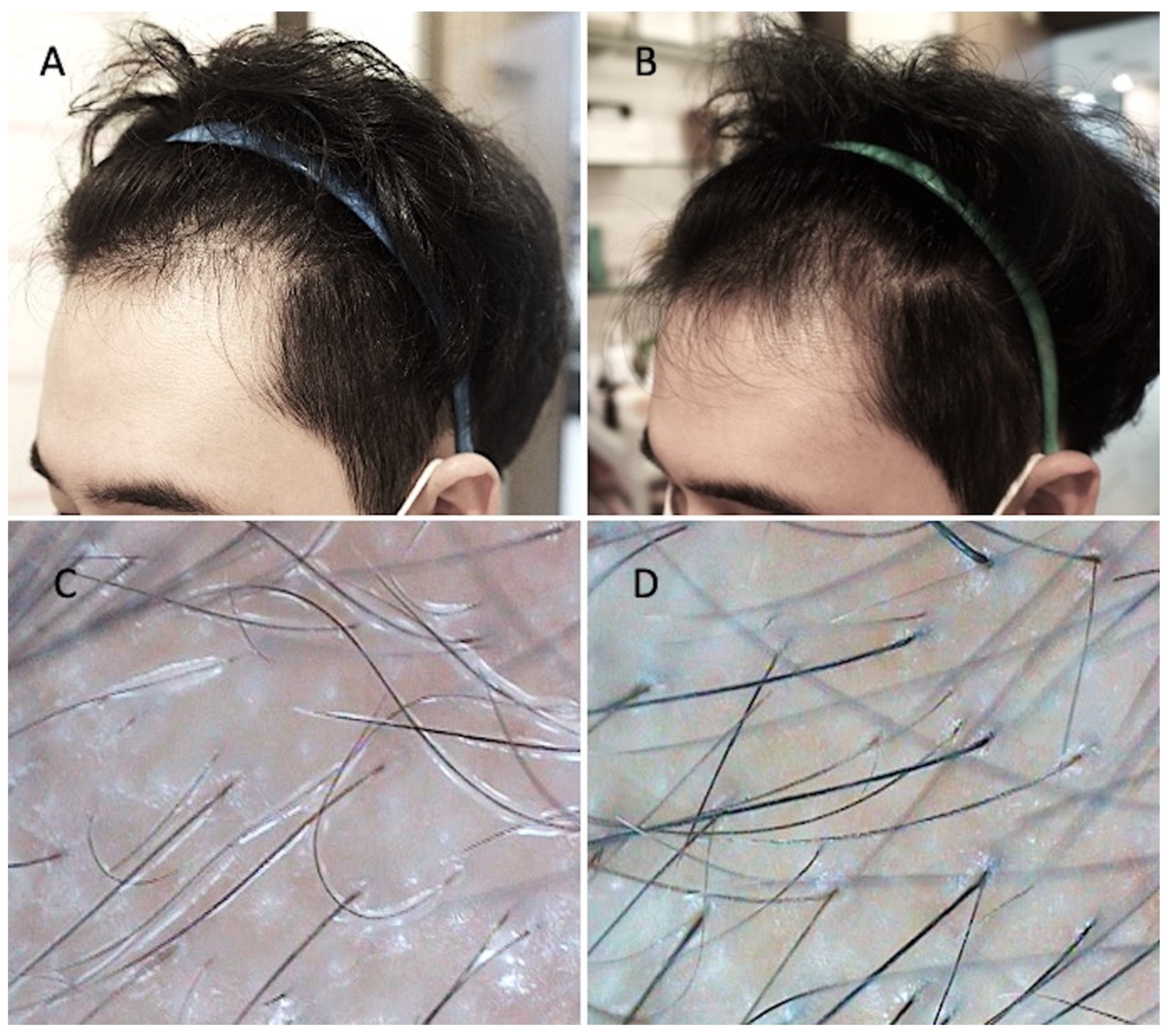Hair Growth Booster Effects of Micro-Needling with Low-Level Led Therapy and Growth Factors on Subjects Treated with Finasteride®
Abstract
:1. Introduction
2. Methods
2.1. Study Overview
2.2. Data Analysis
2.3. Endpoint Definition
2.4. Protocol Based on Hairgen Booster® Application
2.5. Patients Assessment
2.6. Exclusion Criteria
2.7. The Risk Mitigation Measures
- -
- Informed consent for all subjects, including the risks (represented only by ineffective results) and side effects of the treatments;
- -
- Procedure training for subjects;
- -
- A strategy for communicating negative impacts or side effects (represented only by itching, slight redness, slight numbness of the treated part, headache);
- -
- The requirement of CE markings for used devices;
- -
- Need to involve subjects via inclusion and exclusion criteria.
2.8. Trichoscopy Evaluation of the Targeted Area
2.9. Statistical Analysis
3. Results
3.1. Trichoscopy Analysis
3.2. Clinical Evaluation
4. Discussion
5. Conclusions
Author Contributions
Funding
Institutional Review Board Statement
Informed Consent Statement
Conflicts of Interest
References
- Gentile, P.; Garcovich, S.; Scioli, M.G.; Bielli, A.; Orlandi, A.; Cervelli, V. Mechanical and Controlled PRP Injections in Patients Affected by Androgenetic Alopecia. J. Vis. Exp. 2018, e56406. [Google Scholar] [CrossRef]
- Gentile, P.; Calabrese, C.; De Angelis, B.; Dionisi, L.; Pizzicannella, J.; Kothari, A.; De Fazio, D.; Garcovich, S. Impact of the Different Preparation Methods to Obtain Autologous Non-Activated Platelet-Rich Plasma (A-PRP) and Activated Platelet-Rich Plasma (AA-PRP) in Plastic Surgery: Wound Healing and Hair Regrowth Evaluation. Int. J. Mol. Sci. 2020, 21, 431. [Google Scholar] [CrossRef]
- Gentile, P.; Garcovich, S.; Bielli, A.; Scioli, M.G.; Orlandi, A.; Cervelli, V. The Effect of Platelet-Rich Plasma in Hair Regrowth: A Randomized Placebo-Controlled Trial. Stem Cells Transl. Med. 2015, 4, 1317–1323. [Google Scholar] [CrossRef] [PubMed]
- Gentile, P.; Cole, J.P.; Cole, M.A.; Garcovich, S.; Bielli, A.; Scioli, M.G.; Orlandi, A.; Insalaco, C.; Cervelli, V. Evaluation of Not-Activated and Activated PRP in Hair Loss Treatment: Role of Growth Factor and Cytokine Conce.ntrations Obtained by Different Collection Systems. Int. J. Mol. Sci. 2017, 18, 408. [Google Scholar] [CrossRef] [PubMed]
- Gentile, P.; Garcovich, S. Autologous activated platelet-rich plasma (AA-PRP) and non-activated (A-PRP) in hair growth: A retrospective, blinded, randomized evaluation in androgenetic alopecia. Expert Opin. Biol. Ther. 2020, 20, 327–337. [Google Scholar] [CrossRef] [PubMed]
- Gentile, P.; Scioli, M.G.; Bielli, A.; De Angelis, B.; De Sio, C.; De Fazio, D.; Ceccarelli, G.; Trivisonno, A.; Orlandi, A.; Cervelli, V.; et al. Platelet-Rich Plasma and Micrografts Enriched with Autologous Human Follicle Mesenchymal Stem Cells Improve Hair Re-Growth in Androgenetic Alopecia. Biomolecular Pathway Analysis and Clinical Evaluation. Biomedicines 2019, 7, 27. [Google Scholar] [CrossRef] [PubMed]
- Gentile, P. Autologous Cellular Method Using Micrografts of Human Adipose Tissue Derived Follicle Stem Cells in Androgenic Alopecia. Int. J. Mol. Sci. 2019, 20, 3446. [Google Scholar] [CrossRef]
- Gentile, P.; Dionisi, L.; Pizzicannella, J.; de Angelis, B.; de Fazio, D.; Garcovich, S. A randomized blinded retrospective study: The combined use of micro-needling technique, low-level laser therapy and autologous non-activated platelet-rich plasma improves hair re-growth in patients with androgenic alopecia. Expert Opin. Biol. Ther. 2020, 20, 1099–1109. [Google Scholar] [CrossRef]
- Gentile, P.; Garcovich, S.; Lee, S.-I.; Han, S. Regenerative Biotechnologies in Plastic Surgery: A Multicentric, Retrospective, Case-Series Study on the Use of Micro-Needling with Low-Level Light/Laser Therapy as a Hair Growth Boost in Patients Affected by Androgenetic Alopecia. Appl. Sci. 2021, 12, 217. [Google Scholar] [CrossRef]
- Hamblin, M.R. Photobiomodulation for the management of alopecia: Mechanisms of action, patient selection and perspectives. Clin. Cosmet. Investig. Dermatol. 2019, 12, 669–678. [Google Scholar] [CrossRef] [Green Version]
- Joo, H.J.; Jeong, K.H.; Kim, J.E.; Kang, H. Various Wavelengths of Light-Emitting Diode Light Regulate the Proliferation of Human Dermal Papilla Cells and Hair Follicles via Wnt/B-Catenin and the Extracellular Signal-Regulated Kinase Pathways. Ann. Dermatol. 2017, 29, 747. [Google Scholar] [CrossRef]
- Rousso, D.E.; Kim, S.W. A Review of Medical and Surgical Treatment Options for Androgenetic Alopecia. JAMA Facial Plast. Surg. 2014, 16, 444–450. [Google Scholar] [CrossRef]
- Schweiger, E.S.; Boychenko, O.; Bernstein, R.M. Update on the pathogenesis, genetics and medical treatment of patterned hair loss. J. Drugs Dermatol. 2010, 9, 1412–1419. [Google Scholar]
- Price, V.H.; Roberts, J.L.; Hordinsky, M.; Olsen, E.A.; Savin, R.; Bergfeld, W.; Fiedler, V.; Lucky, A.; Whiting, D.A.; Pappas, F.; et al. Lack of efficacy of finasteride in postmenopausal women with androgenetic alopecia. J. Am. Acad. Dermatol. 2000, 43, 768–776. [Google Scholar] [CrossRef]
- Imperato-McGinley, J.; Guerrero, L.; Gautier, T.; Peterson, R.E. Steroid 5α-Reductase Deficiency in Man: An Inherited Form of Male Pseudohermaphroditism. Science 1974, 186, 1213–1215. [Google Scholar] [CrossRef]
- Drake, L.; Hordinsky, M.; Fiedler, V.; Swinehart, J.; Unger, W.P.; Cotterill, P.C.; Thiboutot, D.M.; Lowe, N.; Jacobson, C.; Whiting, D.; et al. The effects of finasteride on scalp skin and serum androgen levels in men with androgenetic alopecia. J. Am. Acad. Dermatol. 1999, 41, 550–554. [Google Scholar]
- Van Neste, D.; Fuh, V.; Sanchez-Pedreno, P.; Lopez-Bran, E.; Wolff, H.; Whiting, D.; Roberts, J.; Kopera, D.; Stene, J.-J.; Calvieri, S.; et al. Finasteride increases anagen hair in men with androgenetic alopecia. Br. J. Dermatol. 2000, 143, 804–810. [Google Scholar] [CrossRef]
- Kaufman, K.D.; Olsen, E.A.; Whiting, D.; Savin, R.; DeVillez, R.; Bergfeld, W.; Price, V.H.; Van Neste, D.; Roberts, J.L.; Hordinsky, M.; et al. Finasteride in the treatment of men with androgenetic alopecia. Finasteride Male Pattern Hair Loss Study Group. J. Am. Acad. Dermatol. 1998, 39, 578–589. [Google Scholar] [CrossRef]
- Schuklenk, U.; Ashcroft, R. International Research Ethics. Bioethics 2000, 14, 158–172. [Google Scholar] [CrossRef]
- Von Elm, E.; Altman, D.G.; Egger, M.; Pocock, S.J.; Gotzsche, P.C.; Vandenbroucke, J.P.; Initiative, S. The Strengthening the Reporting of Observational Studies in Epidemiology (STROBE) statement: Guidelines for reporting observational studies. J. Clin. Epidemiol. 2008, 61, 344–349. [Google Scholar] [CrossRef]
- Gentile, P.; Garcovich, S. The Effectiveness of Low-Level Light/Laser Therapy on Hair Loss. Facial Plast. Surg. Aesthetic Med. 2021; ahead of print. [Google Scholar] [CrossRef]
- Wikramanayake, T.C.; Rodriguez, R.; Choudhary, S.; Mauro, L.M.; Nouri, K.; Schachner, L.A.; Jimenez, J.J. Effects of the Lexington LaserComb on hair regrowth in the C3H/HeJ mouse model of alopecia areata. Lasers Med. Sci. 2011, 27, 431–436. [Google Scholar] [CrossRef] [PubMed]
- Kim, W.S.; Calderhead, R.G. Is light-emitting diode phototherapy (LED-LLLT) effective? Laser Ther. 2011, 20, 205–215. [Google Scholar] [CrossRef] [PubMed]
- Avci, P.; Gupta, G.K.; Clark, J.; Wikonkal, N.; Hamblin, M.R. Low-level laser (light) therapy (LLLT) for treatment of hair loss. Lasers Surg. Med. 2013, 46, 144–151. [Google Scholar] [CrossRef] [PubMed]
- Suchonwanit, P.; Chalermroj, N.; Khunkhet, S. Low-level laser therapy for the treatment of androgenetic alopecia in Thai men and women: A 24-week, randomized, double-blind, sham device-controlled trial. Lasers Med. Sci. 2018, 34, 1107–1114. [Google Scholar] [CrossRef]
- Ash, C.; Harrison, A.; Drew, S.; Whittall, R. A randomized controlled study for the treatment of acne vulgaris using high-intensity 414 nm solid state diode arrays. J. Cosmet. Laser Ther. 2015, 17, 170–176. [Google Scholar] [CrossRef]
- Naranjo García, P.; Elias, J.A.; Gaviria Parada, J.; Zarza Luciañez, D.; Pinto, H.R. Management of Vaginal Atrophy with Intravaginal Light-Emitting Diodes (LEDs). Int. J. Obstet. Gyanecol. Res. 2018, 5, 632–641. [Google Scholar]
- Calderhead, R.G.; Vasily, D.B. Low Level Light Therapy with Light-Emitting Diodes for the Aging Face. Clin. Plast. Surg. 2016, 43, 541–550. [Google Scholar] [CrossRef]
- Weiss, R.A.; McDaniel, D.H.; Geronemus, R.G.; Weiss, M.A. Clinical trial of a novel non-thermal LED array for reversal of photoaging: Clinical, histologic, and surface profilometric results. Lasers Surg. Med. 2005, 36, 85–91. [Google Scholar] [CrossRef]
- Lanzafame, R.J.; Blanche, R.R.; Chiacchierini, R.P.; Kazmirek, E.R.; Sklar, J.A. The growth of human scalp hair in females using visible red light laser and LED sources. Lasers Surg. Med. 2014, 46, 601–607. [Google Scholar] [CrossRef]
- Friedman, S.; Schnoor, P. Novel Approach to Treating Androgenetic Alopecia in Females with Photobiomodulation (Low-Level Laser Therapy). Dermatol. Surg. 2017, 43, 856–867. [Google Scholar] [CrossRef]
- Kim, H.; Choi, J.W.; Kim, J.Y.; Shin, J.W.; Lee, S.-J.; Huh, C.-H. Low-Level Light Therapy for Androgenetic Alopecia: A 24-Week, Randomized, Double-Blind, Sham Device–Controlled Multicenter Trial. Dermatol. Surg. 2013, 39, 1177–1183. [Google Scholar] [CrossRef] [PubMed]
- Darwin, E.; Heyes, A.; Hirt, P.A.; Wikramanayake, T.C.; Jimenez, J.J. Low-level laser therapy for the treatment of androgenic alopecia: A review. Lasers Med. Sci. 2018, 21, 425–434. [Google Scholar] [CrossRef]
- Barikbin, B.; Khodamrdi, Z.; Kholoosi, L.; Akhgri, M.R.; Abbasi, M.H.; Hajabbasi, M.; Razzaghi, Z.; Akbarpour, S. Comparison of the effects of 665 nm low level diode Laser Hat versus and a combination of 665 nm and 808 nm low level diode Laser Scanner of hair growth in androgenic alopecia. J. Cosmet. Laser Ther. 2017; just-accepted. [Google Scholar] [CrossRef]
- Afifi, L.; Maranda, E.L.; Zarei, M.; Delcanto, G.M.; Falto-Aizpurua, L.; Kluijfhout, W.P.; Jimenez, J.J. Low-level laser therapy as a treatment for androgenetic alopecia. Lasers Surg. Med. 2016, 49, 27–39. [Google Scholar] [CrossRef] [PubMed]
- Avram, M.R.; Rogers, N.E. The use of low-level light for hair growth: Part I. J. Cosmet. Laser Ther. 2009, 11, 110–117. [Google Scholar] [CrossRef] [PubMed]
- Sorbellini, E.; Rucco, M.; Rinaldi, F. Photodynamic and photobiological effects of light-emitting diode (LED) therapy in dermatological disease: An update. Lasers Med. Sci. 2018, 33, 1431–1439. [Google Scholar] [CrossRef]
- Leavitt, M.; Charles, G.; Heyman, E.; Michaels, D. HairMax LaserComb® laser phototherapy device in the treatment of male androgenetic alopecia: A randomized, double-blind, sham device-controlled, multicentre trial. Clin. Drug Investig. 2009, 29, 283–292. [Google Scholar] [CrossRef]
- Lanzafame, R.J.; Blanche, R.R.; Bodian, A.B.; Chiacchierini, R.P.; Fernandez-Obregon, A.; Kazmirek, E.R. The growth of human scalp hair mediated by visible red light laser and LED sources in males. Lasers Surg. Med. 2013, 45, 487–495. [Google Scholar] [CrossRef]
- Esmat, S.M.; Hegazy, R.A.; Gawdat, H.I.; Hay, R.A.; Allam, R.; El Naggar, R.; Moneib, H. Low level light-minoxidil 5% combination versus either therapeutic modality alone in management of female patterned hair loss: A randomized controlled study. Lasers Surg. Med. 2017, 49, 835–843. [Google Scholar] [CrossRef]
- Roberts, J.L.; Fiedler, V.; Imperato-McGinley, J.; Whiting, D.; Olsen, E.; Shupack, J.; Stough, D.; DeVillez, R.; Rietschel, R.; Savin, R. Clinical dose-ranging studies with finasteride, a type 2 5α-reductase inhibitor, in men with male pattern hair loss. J. Am. Acad. Dermatol. 1999, 41, 555–563. [Google Scholar]
- Olsen, E.A.; Dunlap, F.E.; Funicella, T.; Koperski, J.A.; Swinehart, J.M.; Tschen, E.H.; Trancik, R.J. A randomized clinical trial of 5% topical minoxidil versus 2% topical minoxidil and placebo in the treatment of androgenetic alopecia in men. J. Am. Acad. Dermatol. 2002, 47, 377–385. [Google Scholar] [CrossRef]
- Jimenez, J.J.; Wikramanayake, T.C.; Bergfeld, W.; Hordinsky, M.; Hickman, J.G.; Hamblin, M.R.; Schachner, L.A. Efficacy and Safety of a Low-level Laser Device in the Treatment of Male and Female Pattern Hair Loss: A Multicenter, Randomized, Sham Device-controlled, Double-blind Study. Am. J. Clin. Dermatol. 2014, 15, 115–127. [Google Scholar] [CrossRef] [PubMed] [Green Version]




| Paitents | Sex | Hamilton-Norwood Degree | Ludwig Degree | Targeted Area | Age | Race | Situation |
|---|---|---|---|---|---|---|---|
| 1 | Male | IV | - | Frontal, temporal, parietal, vertex | 69 | Caucasian | Hair growth stalled |
| 2 | Male | II | - | Frontal, temporal, | 21 | Asian | No good results |
| 3 | Male | VI | - | Frontal, temporal, parietal, vertex | 73 | Caucasian | Hair growth stalled |
| 4 | Male | III | - | Frontal, temporal, parietal | 29 | Asian | No good results |
| 5 | Male | IV | - | Frontal, temporal, parietal, vertex | 68 | Caucasian | Hair growth stalled |
| 6 | Male | III-vertex | - | Frontal, temporal, parietal, vertex | 46 | Asian | No good results |
| 7 | Male | III-vertex | - | Frontal, temporal, parietal, vertex | 44 | Caucasian | Hair growth stalled |
| 8 | Male | VI | - | Frontal, temporal, parietal, vertex | 46 | Asian | Hair growth stalled |
| 9 | Male | IV | - | Frontal, temporal, parietal, vertex | 41 | Caucasian | No good results |
| 10 | Male | III-vertex | - | Frontal, temporal, parietal, vertex | 31 | Asian | Hair growth stalled |
| 11 | Male | V | - | Frontal, temporal, parietal, vertex | 50 | Caucasian | No good results |
| 12 | Male | III | - | Frontal, temporal, parietal | 34 | Asian | Hair growth stalled |
| 13 | Male | IV | - | Frontal, temporal, parietal, vertex | 59 | Caucasian | No good results |
| 14 | Male | II | - | Frontal, temporal | 39 | Asian | Hair growth stalled |
| 15 | Male | V | - | Frontal, temporal, parietal, vertex | 62 | Caucasian | No good results |
| 16 | Male | V | - | Frontal, temporal, parietal, vertex | 62 | Caucasian | Hair growth stalled |
| 17 | Female | - | II | Frontal, parietal, temporal | 58 | Caucasian | No good results |
| 18 | Female | - | III | Frontal, parietal, temporal, vertex | 49 | Asian | No good results |
| 19 | Female | - | II | Frontal, parietal, temporal | 69 | Caucasian | Hair growth stalled |
| 20 | Female | - | III | Frontal, parietal, temporal, vertex | 50 | Asian | Hair growth stalled |
| Patients | Procedure | Hair Density (T0) | Hair Density (T1, 20 wks) |
|---|---|---|---|
| 1 | Hairgen booster® | 41 ± 5 | 60 ± 5 |
| 2 | Hairgen booster® | 40.5 ± 5 | 59.5 ± 5 |
| 3 | Hairgen booster® | 51 ± 5 | 70 ± 5 |
| 4 | Hairgen booster® | 35 ± 5 | 54 ± 5 |
| 5 | Hairgen booster® | 65 ± 5 | 84 ± 5 |
| 6 | Hairgen booster® | 83 ± 5 | 102 ± 5 |
| 7 | Hairgen booster® | 180.5 ± 5 | 199 ± 5 |
| 8 | Hairgen booster® | 17.5 ± 5 | 36.5 ± 5 |
| 9 | Hairgen booster® | 40 ± 5 | 59± 5 |
| 10 | Hairgen booster® | 39 ± 5 | 58 ± 5 |
| 11 | Hairgen booster® | 50 ± 2 | 69 ± 2 |
| 12 | Hairgen booster® | 75 ± 5 | 94 ± 5 |
| 13 | Hairgen booster® | 40 ± 2 | 59 ± 2 |
| 14 | Hairgen booster® | 65 ± 5 | 84 ± 5 |
| 15 | Hairgen booster® | 38 ± 5 | 57 ± 5 |
| 16 | Hairgen booster® | 48 ± 5 | 67 ± 5 |
| 17 | Hairgen booster® | 71 ± 5 | 90 ± 5 |
| 18 | Hairgen booster® | 30 ± 5 | 49 ± 5 |
| 19 | Hairgen booster® | 60 ± 5 | 79 ± 5 |
| 20 | Hairgen booster® | 32 ± 5 | 51 ± 5 |
Publisher’s Note: MDPI stays neutral with regard to jurisdictional claims in published maps and institutional affiliations. |
© 2022 by the authors. Licensee MDPI, Basel, Switzerland. This article is an open access article distributed under the terms and conditions of the Creative Commons Attribution (CC BY) license (https://creativecommons.org/licenses/by/4.0/).
Share and Cite
Gentile, P.; Ki, M.-S. Hair Growth Booster Effects of Micro-Needling with Low-Level Led Therapy and Growth Factors on Subjects Treated with Finasteride®. Appl. Sci. 2022, 12, 9164. https://doi.org/10.3390/app12189164
Gentile P, Ki M-S. Hair Growth Booster Effects of Micro-Needling with Low-Level Led Therapy and Growth Factors on Subjects Treated with Finasteride®. Applied Sciences. 2022; 12(18):9164. https://doi.org/10.3390/app12189164
Chicago/Turabian StyleGentile, Pietro, and Mun-Sang Ki. 2022. "Hair Growth Booster Effects of Micro-Needling with Low-Level Led Therapy and Growth Factors on Subjects Treated with Finasteride®" Applied Sciences 12, no. 18: 9164. https://doi.org/10.3390/app12189164
APA StyleGentile, P., & Ki, M.-S. (2022). Hair Growth Booster Effects of Micro-Needling with Low-Level Led Therapy and Growth Factors on Subjects Treated with Finasteride®. Applied Sciences, 12(18), 9164. https://doi.org/10.3390/app12189164








